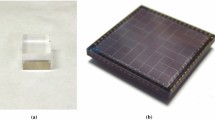Abstract
For high-spatial-resolution reconstructions in SPECT imaging, an accurate and fine system matrix (H matrix) should be constructed. In this study, the modified Gaussian interpolation method (GIM) and the modified GIM combined with geometric parameter estimations (GIMGPE) are developed to rapidly construct the complete H matrices of circular-orbit 1-pinhole/4-pinhole SPECT systems. The multi-module multi-resolution (M3R) pinhole SPECT system (in the Center for Gamma-Ray Imaging, University of Arizona) is utilized to verify the usefulness of the proposed interpolation methods. The modified GIM and GIMGPE apply a geometric calibration, a rough grid-scan experiment, and point response parameterization based on Gaussian fitting to construct the full H matrices with a 0.5-mm voxel size and 60 projection angles. The geometric calibration uses a 3-point calibration phantom projected at 60 projection angles to construct the geometric projection model. In the rough grid-scan experiment, a point source is stepped on a regular grid pattern with a 1-mm grid spacing to measure the point response functions (PRFs) at the 0° projection angle. Sequentially, the measured PRFs are parameterized into two-dimensional Gaussians. The PRFs of full H matrices are interpolated by the relations between the Gaussian coefficients and the geometric parameters. The processing time of constructing the complete H matrices with the modified GIM and GIMGPE are respectively reduced by about 347× and 336×, compared to that of the full three-dimensional grid-scan experiment. According to the results of geometric calibration, the magnification of M3R with 1- and 4-pinhole patterns are 1.9× and 2.6×, respectively. The reconstructions of a hot-rod phantom show that the spatial resolutions of M3R with 1- and 4-pinhole patterns are 1.4 mm and 1.0 mm, respectively.









Similar content being viewed by others
References
de Kemp, R. A., Epstein, F. H., Catana, C., Tsui, B. M. W., & Ritman, E. L. (2010). Small-animal molecular imaging methods. Journal of Nuclear Medicine, 51, 18S–32S.
Khalil, M. M., Tremoleda, J. L., Bayomy, T. B., & Gsell, W. (2011). Molecular SPECT imaging: An overview. International Journal of Molecular Imaging, 2011, 796025.
Mu, Z.-P., Dobrucki, L. W., & Liu, Y.-H. (2016). SPECT imaging of 2-D and 3-D distributed sources with near-field coded aperture collimation: computer simulation and real data validation. Journal of Medical and Biological Engineering, 36, 32–43.
Barrett, H. H., & Myers, K. J. (2004). Foundations of image science. Hoboken: Wiley.
Hsieh, H.-H., Hsu, C.-H., Mok, G. S. P., Tsai, Y.-J., Chang, S.-I. & Hsiao, I.-T. (2010). System matrix based on sensitivity model for small animal multi-pinhole SPECT system. In IEEE NSS/MIC Conference Rec (pp. 3308–3311)
El Bitar, Z., Huesman, R. H., Boutchko, R., Bekaert, V., Brasse, D., & Gullberg, G. T. (2013). A detector response function design in pinhole SPECT including geometric calibration. Physics in Medicine & Biology, 58, 2395–2411.
Lefkoupoulos, D., Fonroget, J., Devaux, J. Y., Guilhem, J. B., Roucayrol, J. C. & Guiranud, R. (1983). Quantitative 3D imaging with coded apertures by using SVD decomposition of the transmission matrix. In Nuclear medicine and biology advances: Proceedings of the third world congress of nuclear medicine and biology (Vol. 503–506)
Furenlid, L. R., Wilson, D. W., Chen, Y., Kim, H., Pietraski, P. J., Crawford, M. J., et al. (2004). FastSPECT II: A second-generation high-resolution dynamic SPECT imager. IEEE Transactions on Nuclear Science, 51, 631–635.
Beque, D., Nuyts, J., Suetens, P., & Bormans, G. (2005). Optimization of geometric calibration in pinhole SPECT. IEEE Transactions on Medical Imaging, 24, 180–190.
Wang, Y. C., & Tsui, B. M. W. (2007). Pinhole SPECT with different data acquisition geometries: Usefulness of unified projection operators in homogeneous coordinates. IEEE Transactions on Medical Imaging, 26, 298–308.
Rowe, R. K., Aarsvold, J. N., Barrett, H. H., Chen, J. C., Klein, W. P., Moore, B. A., et al. (1993). A stationary hemispherical SPECT imager for three-dimensional brain imaging. Journal of Nuclear Medicine, 34, 474–480.
Chen, Y. C., Furenlid, L. R., Wilson, D. W., & Barrett, H. H. (2005). Calibration of scintillation cameras and pinhole SPECT imaging system. In M. A. Kupinski & H. H. Barrett (Eds.), Small-animal SPECT imaging (pp. 195–201). New York: Springer.
Chen, Y. C. (2006). System calibration and image reconstruction for a new small-animal SPECT system, Ph.D. dissertation, University of Arizona, Tucson, Arizona.
Lee, M. W., & Chen, Y. C. (2014). Rapid construction of pinhole SPECT system matrices by distance-weighted Gaussian interpolation method combined with geometric parameters estimations. Nuclear Instruments and Methods in Physics Research A, 737, 122–134.
Hesterman, J. Y., Kupinski, M. A., Furenlid, L. R., Wilson, D. W., & Barrett, H. H. (2007). The multi-module, multi-resolution system (M3R): a novel small-animal SPECT system. Medical Physics, 34, 987–993.
Lee, M. W., Lin, W. T., Ni, Y. C., Jan, M. L. & Chen, Y. C. (2012). Rapid construction of circular orbit pinhole SPECT imaging system matrices by Gaussian interpolation method combined with geometric parameter estimations. In The 5th biennial workshop on small-animal SPECT imaging, Tucson, Arizona, USA, November 6–8.
J. Y. Hesterman, The Multi-module multi-resolution SPECT system: A tool for variable-pinhole small-animal imaging, Ph.D. dissertation, University of Arizona, Tucson, Arizona, 2007.
Metzler, S. D., & Jaszczak, R. J. (2006). Simultaneous multi-head calibration for pinhole SPECT. IEEE Transactions on Nuclear Science, 53, 113–120.
Tsai, Y.-J., Huang, H.-M., Chou, C.-Y., Wang, W.-C., & Hsiao, I.-T. (2015). Effective anatomical priors for emission tomographic reconstruction. Journal of Medical and Biological Engineering, 35, 52–61.
Acknowledgments
This work was supported in part by the National Science Council of Taiwan under grants NSC-101-2918-I-008-010 and NSC-102-2221-E-008-047. The authors are grateful to the Center for Gamma-Ray Imaging at the University of Arizona for their generous sharing of the M3R apparatus.
Author information
Authors and Affiliations
Corresponding author
Rights and permissions
About this article
Cite this article
Lee, MW., Chen, YC. Modified Gaussian Interpolations with Geometric Calibrations for Rapid Constructions of Circular-Orbit Pinhole SPECT System Matrices. J. Med. Biol. Eng. 36, 515–525 (2016). https://doi.org/10.1007/s40846-016-0160-x
Received:
Accepted:
Published:
Issue Date:
DOI: https://doi.org/10.1007/s40846-016-0160-x




